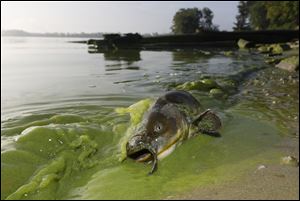
State response to Lake Erie algae problem will take time
8/30/2018
A catfish appears on the shoreline in the algae-filled waters of Toledo in September, 2017.
REYNOLDSBURG, Ohio — Members of a state task force on Thursday made it clear they will not be rushed into making a decision on Gov. John Kasich’s request that some eight watersheds in the Maumee River Basin be declared distressed.
The panel, an offshoot of the independent Ohio Soil and Water Conservation Commission, held its first meeting to discuss the science behind the phosphorous runoff problem fueling recurring toxic algal blooms on Lake Erie and whether declaring 40 percent of the lake’s western basis to be distressed is the answer.
“Ohio’s being watched almost nationwide on how this subgroup is going to handle the requirements of putting a distressed watershed in place,” said Tom Price, the commission’s chairman and a member of its task force.
“This is no small task and no small responsibility,” he said. “It has implications far beyond what we’re doing here in the western basin of Lake Erie. ... I think it behooves us to stand back and look at everything that’s going on.”
Last month Mr. Kasich signed an executive order directing his administration to request distressed status for eight full and partial watersheds in northwest Ohio because of their high phosphorous levels.
That would have triggered new rules requiring the nearly 7,000 farmers in the region to adopt nutrient management plans, violations of which could lead to financial penalties.
But the full commission voted 4-2 to punt the issue to this panel for more discussion. The task force includes, among others, three commissioners, representatives of farming organizations, scientists, and local soil and water conservation districts.
The panel will try to reach consensus on whether to recommend the full commission approve, reject, or modify the governor’s request. The subgroup will next meet on Oct. 4 while the full commission is scheduled to meet in November.
“I think farmers are accepting that we need to make some changes, but there’s some uncertainty in the science,” said Kris Swartz, a Perrysburg Township farmer, past president of the Ohio Federation of Soil and Water Conservation Districts, and task force member.
“There’s uncertainty as to what watersheds really are distressed,” he said. “If you’re a farmer, and you want to buy into this approach, you're getting conflicting ideas and items … If farmers or their organizations aren’t behind this designation, it’s not going to be effective.”
Topics the task force will delve into are: the effectiveness of methods to prevent erosion and nutrient runoff; whether granular fertilizers, manure, or both are to blame; who would enforce farmer responses; and how farmers would pay for it.
The Ohio Federation’s Nichole Hawk said the state has learned from its response to algal problems at Grand Lake St. Marys about 30 miles southwest of Lima. But she noted that the St. Marys watershed of some 57,000 acres is dwarfed by the size of the proposed declaration in northwest Ohio of nearly 1.8 million acres.
“Research does indicate that there was a positive impact on water quality in Grand Lake after the distressed designation,” she said. “However, there’s no clear connection strictly that that was related to nutrient management plans.”
In the meantime, the Department of Agriculture has proposed rules for public comment and is proceeding along a parallel path of hoping to have final rules ready should the full commission ultimately approve the administration’s request.
The administration’s request would affect the Platter Creek, Little Flat Rock Creek, Little Auglaize River, Eagle Creek, Auglaize River, Blanchard River, St. Marys River, and Ottawa River watersheds and sub-watersheds.
The administration argues that efforts to date to encourage voluntary adoption by farmers of fertilizer best practices of waterways have had next to no impact on phosphorous loading. Ohio, Michigan, and Ontario, Canada, have committed to reducing levels by 40 percent by 2025.
Contact Jim Provance at jprovance@theblade.com or 614-221-0496.